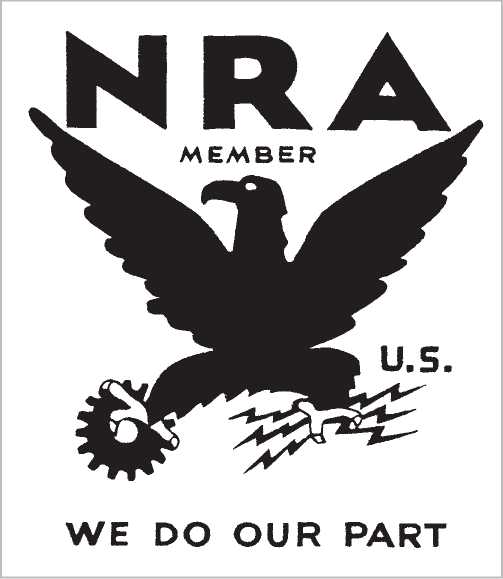Created by Title I of the National Industrial Recovery Act (NIRA) of June 16, 1933, the National Recovery Administration (NRA) was one of the cornerstone agencies of the so-called First New Deal of 1933. It sought to lift the industrial sector of the economy out of the Great Depression by means of cartel-like agreements on production, prices, wages, and labor in various industries. Although the NRA proved unable to produce economic expansion, became increasingly unpopular, and was declared unconstitutional by the Supreme Court in 1935, it was nonetheless one of the important programs of the New Deal.
Ideas leading to the NRA came from several sources. business had long understood that agreements on prices and production limits might bring stability to an industry by eliminating price-cutting and overproduction, and trade associations in the 1920s had advocated exemption from antitrust laws to enable industry-wide production and marketing policies. The War Industries Board of World War I had involved production agreements worked out by government and business organizations. A segment of liberalism going back to the Progressive Era embraced economic concentration, with government planning and controls to make it more efficient and equitable. During the depression, a number of labor leaders, especially in the most troubled industries, believed that agreements on production and prices might stabilize employment and wages. The Brain Trust of President Franklin D. Roosevelt inclined toward accepting large organizations and planned economic activities as an approach to the depression. Such ideas sometimes differed considerably. Business wanted self-regulation approved by the government, for example, while such liberals as REXfoRD G. Tugwell wanted thoroughgoing government planning and controls over business. But these various approaches had in common some version of national planning to stabilize the industrial sector of the economy and produce expansion and recovery.
General Hugh S. Johnson, who had served on the War Industries Board and preferred the business selfgovernment approach, was NRA’s first administrator and together with New York senator Robert F. Wagner had played a role in drafting the National Industrial Recovery Act. The NIRA suspended the antimonopoly laws for two years so that industrial organizations could draft, in conjunction with labor and consumer representatives as

Shown here is the logo of the National Recovery Administration (NRA), a New Deal agency. (New York Public Library)
Well as with government officials, codes of fair competition on prices, production, wages, and labor conditions. The complicated legislation was nearer to the business selfregulation than it was to the government-control model, but it did require presidential approval of codes and the government could impose codes when an industry did not come to agreement. In return for labor support, Section 7(a) of the NIRA authorized labor’s right to organize and bargain collectively.
Johnson, a hard-drinking, mercurial, colorful figure, launched an aggressive publicity effort and conducted a frenetic “We Do Our Part” campaign to get industries to cooperate in approving codes—and winning the NRA Blue Eagle emblem. Until specific industry codes were approved, he asked employers to sign a “blanket code” with minimum, maximum hours, and the end of child labor, and he urged consumers to deal only with businesses displaying the Blue Eagle. Eventually, 541 hastily written codes were approved, many in industries where the codes were unnecessary, irrelevant, or simply not worth the time and effort. Other industries involved codes that seemed almost impossibly complicated and often inconsistent. A large bureaucracy inevitably emerged.
After an initial “NRA boom,” caused largely by manufacturers trying to beat the implementation of the codes, industrial production briefly turned down again, and the NRA did little to stimulate economic expansion. Probably it did help arrest the economy’s downward spiral, but it did not provide impetus for recovery, for it was restric-tionist rather than expansionist. Prices were set too high to increase buying (and thus production and employment), while production quotas gave no incentive for businesses to cut costs, improve products, and create new demand. Moreover, the Public Works Administration, a companion agency created by the NIRA to pump money into the economy, spent too slowly to have any real economic stimulus. The NRA did, however, make significant progress in reducing child labor and increasing labor organization.
A failure at achieving recovery, NRA also became more and more unpopular. Business and conservatives increasingly disliked government regulation and bureaucracy. Liberals, labor, consumers, and small business thought big business and trade associations had too much say in drafting and implementing the codes. Small business and liberals believed that the NRA codes fostered and protected monopoly. Consumers, labor, and liberals thought prices too high. Labor was unhappy with employers for evading Section 7(a) and with Johnson and the NRA for not enforcing it. In 1934, Roosevelt prevailed upon Johnson to resign, but no improvement came in results or acceptance.
By 1935, the NRA seemed an unpopular failure, and its future was questionable. In May, in the case of Schechter Poultry Corporation v. United States, the Supreme Court found the NIRA (and thus the NRA) unconstitutional for exceeding the power of the federal government by regulating intrastate commerce and for wrongly delegating legislative authority to the executive branch in the code-making process. The NRA was terminated in 1936, though “little NRAs” were established in coal and some other industries in transportation, natural resources and service, and the National Labor Relations Act replaced and greatly expanded Section 7(a). The failure of the NRA led the New Deal to turn to other approaches at economic recovery, reform, and regulation.
Further reading: Bernard Bellush, The Failure of the NRA (New York: Norton, 1975); Ellis W. Hawley, The New Deal and the Problem of Monopoly (Princeton, N. J.: Princeton University Press, 1966).




 World History
World History









